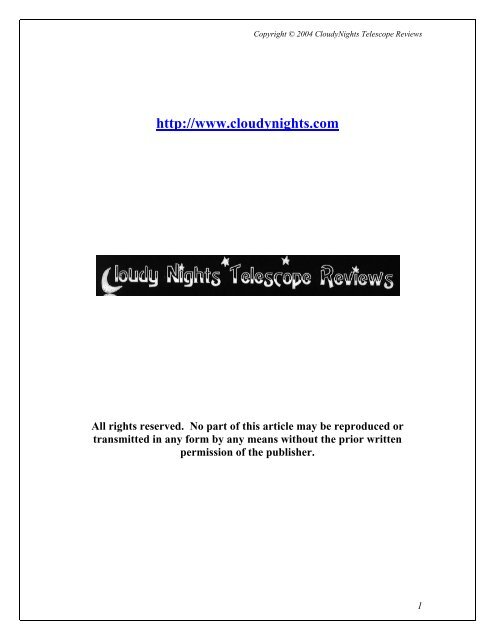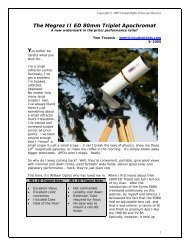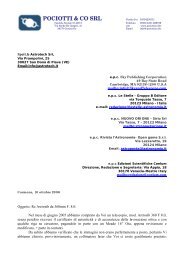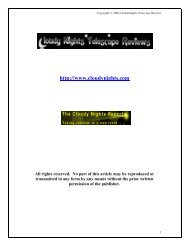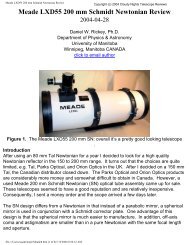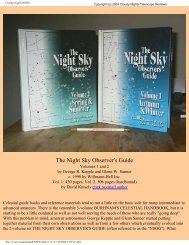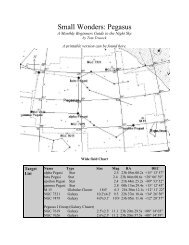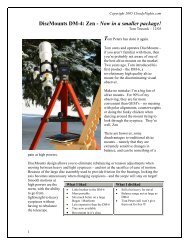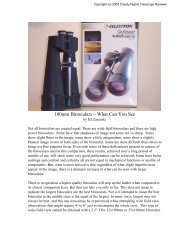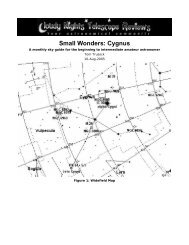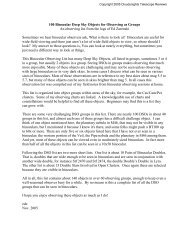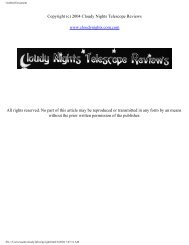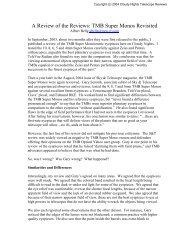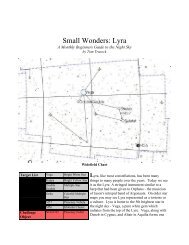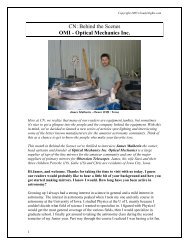Reflex Finder Shootout - Cloudy Nights
Reflex Finder Shootout - Cloudy Nights
Reflex Finder Shootout - Cloudy Nights
Create successful ePaper yourself
Turn your PDF publications into a flip-book with our unique Google optimized e-Paper software.
Copyright © 2004 <strong>Cloudy</strong><strong>Nights</strong> Telescope Reviews<br />
http://www.cloudynights.com<br />
All rights reserved. No part of this article may be reproduced or<br />
transmitted in any form by any means without the prior written<br />
permission of the publisher.<br />
1
The <strong>Reflex</strong> <strong>Finder</strong> <strong>Shootout</strong><br />
5/2004 Tom Trusock - Click to e-mail author<br />
Copyright © 2004 <strong>Cloudy</strong><strong>Nights</strong> Telescope Reviews<br />
Unit Power <strong>Finder</strong>s, <strong>Reflex</strong> <strong>Finder</strong>s, Reticule <strong>Finder</strong>s and Red Dot <strong>Finder</strong>s or RDF’s<br />
call them by any name you like, many amateurs today have one of these units on their<br />
scope. For some, it replaces the traditional optical finder scope, for others it supplements<br />
it. Depending on the size and the focal ratio of the telescope, I personally find that I<br />
either prefer a reflex finder or both optical and reflex units.<br />
A reflex finder allows me to quickly and accurately place an object in the FOV of most of<br />
my eyepieces (even at moderate to high powers) with out having to fish around and<br />
determine exactly where in the sky my optical finder is pointing. In short – it allows you<br />
to spot a star in the night and point your telescope – “there”.<br />
The reflex finder craze started in the late 70’s when amateur Steve Kufield designed a<br />
unit power finder based on the World War II era Norden bombsight, and the whole<br />
concept has come a long way since then.<br />
In this article, I’ll take a look at nine different reflex sights. Some are reticule based –<br />
this means they project a series of concentric circles on the night sky like a bulls eye,<br />
while others only project a dot – usually red. The red dot sights are also commonly<br />
referred to as RDF’s for Red Dot <strong>Finder</strong>s.<br />
Every single unit in this review worked as advertised. They all enabled me to find<br />
objects in the night sky, however some were markedly better than others. You can pay<br />
anything from $12 to $240 for a reflex sight, and then turn around and buy accessories<br />
for some models. What you buy in the end should best fit your scopes and observing<br />
style.<br />
To give you some impression of scale, I’ve shown a Canyon Diablo meteorite that’s<br />
47.43mm long at it’s longest point, and 28.56mm at its widest in each picture. I also<br />
show you a scaled image of the pattern that is projected on the night sky. Please note, the<br />
apparent size of the reticule finders depend on how close your eye is to the finder, but this<br />
will give you an idea of how the patterns relate to one another size wise. Note that the<br />
dot is smaller on the Giant Mars Eye <strong>Finder</strong> than on the other RDF’s in our line up.<br />
Additionally, all measurements of physical size include the base. I mixed mm and inches<br />
in my units because most US citizens still tend to think in inches (and because most of<br />
our overseas / out of country friends are (by this time) used to putting up with the foibles<br />
of Americans), but the millimeter measurements are more accurate and still easy to grasp<br />
when talking comparison of clear aperture.<br />
2
Telrad<br />
Rating: ****<br />
Copyright © 2004 <strong>Cloudy</strong><strong>Nights</strong> Telescope Reviews<br />
Price: $39.95<br />
Includes base: Yes<br />
Weight: 10.8 OZ<br />
Clear Area: 35.95mm x 62.98mm<br />
Window Tint: Clear<br />
Accessories available: Pulser ($21), Kendrick Telrad Heater($26), Dew Shield+ ($25),<br />
Spare Base, Sun Spotter<br />
Reticule Size: Held 6” from nose, reticule size is 16.5mm<br />
Ring Scale: four degrees, two degrees, half degree (exact)<br />
Other Features: Three rings, Red, adjustable brightness<br />
Batteries: 2 AA<br />
Physical size: 8.25 1 / 5 h / 2.25 w (inches)<br />
Alignment: three finger knobs allow for hand adjustment<br />
The largest, oldest, and one of the most rugged unit power finders in our round up, the<br />
Telrad is also one of the nicest to use for star hopping with it’s precisely calibrated<br />
reticules – IF you have a large scope. Due to it’s rather large size and weight (which<br />
ironically is quite unnecessary – it’s mostly empty ABS plastic) it tends to be a bit<br />
awkward to use on smaller scopes or refractors. The exposed window is also extremely<br />
prone to dew in wet environs.<br />
Recommended for large scopes only<br />
3
Galileo CIR (Calibrated Image Reticule)<br />
Rating: **<br />
Price: $19.95<br />
Includes base: yes<br />
Weight: 6.3 OZ<br />
Clear Area: 40.77 x 34.90<br />
Window Tint: Clear<br />
Accessories available: None<br />
Reticule Size: Held 6” from nose, reticule size is 6.5mm<br />
Ring Scale: not calibrated<br />
Other Features: Three rings, red, adjustable brightness<br />
Batteries: 2 AA<br />
Physical Size: 5.25 1 / 4.25 h / 2 w (inches)<br />
Alignment: two finger knobs allow for hand adjustment<br />
Copyright © 2004 <strong>Cloudy</strong><strong>Nights</strong> Telescope Reviews<br />
A cross between the Telrad and the Rigel, this little unit is between the two in physical<br />
size and priced lower. I found it a bit harder to use (it was more sensitive to eye<br />
placement, and the reticules are tiny), and was dismayed to find that (contrary to the<br />
name of the finder) the reticules did not appear to be calibrated to any standard. In<br />
practice, that makes it no better than a much smaller and lighter dot finder. The exposed<br />
window is also prone to dew.<br />
Not Recommended.<br />
4
Giant Mars Eye <strong>Finder</strong><br />
Rating: **** and ½*<br />
Price: $24.95/$15.95 (sale)<br />
Includes base: No (uses weaver type)<br />
Weight: 2.1 OZ<br />
Clear Diameter: 29.95 mm<br />
Window Tint: very light grey<br />
Accessories available: None<br />
Other Features: Red or Green Pinpoint, adjustable brightness<br />
Battery: CR2032<br />
Physical Size: 4.25 1 / 2.5 h / 1.5 w (inches)<br />
Alignment: two finger knobs allow for hand adjustment<br />
Copyright © 2004 <strong>Cloudy</strong><strong>Nights</strong> Telescope Reviews<br />
The Giant Mars Eye does everything that a RDF should – and offers you a color option to<br />
boot. The large clear window of the finder made lining up objects a snap, and the dot got<br />
dim enough for use at a dark site. You will need to pick up a mounting block (any<br />
weaver type base will do – either the TeleVue or StellarVue block/base units will work<br />
fine) or plan on using double sided tape to secure it to your scope. It, like most of the rest<br />
of the reflex finders, is prone to dew.<br />
Highly Recommended<br />
TeleVue QuickPoint<br />
Rating: **<br />
5
Price: $29.99<br />
Includes base: yes (uses weaver type)<br />
Weight: 1.4 OZ<br />
Clear diameter: 13.86 mm<br />
Window Tint: grey<br />
Accessories available: None<br />
Other Features: Red Dot, adjustable brightness<br />
Battery: CR2032<br />
Physical Size: 4.75 1 / 1.75 h / .9 w (inches)<br />
Alignment: screwdriver necessary<br />
Copyright © 2004 <strong>Cloudy</strong><strong>Nights</strong> Telescope Reviews<br />
Made by Daisy and sold by TeleVue, the QuickPoint is one of the older RDF’s on the<br />
market. I found its tiny dark tinted window often made finding objects a bit of a chore,<br />
and I was afraid I would snag the exposed PCB for the dimmer circuit on my clothing.<br />
Although I’ve personally owned two of these units over the years, I find it hard to<br />
recommend given the other options available on the market.<br />
Not Recommended<br />
Vixen Red Dot <strong>Finder</strong><br />
Rating: ****<br />
Price: $69.95<br />
Base included: No (uses Vixen/Synta type)<br />
Weight: 7.4 oz<br />
Clear Diameter: 24.1mm<br />
6
Window Tint: Grey/Blue/Green/Red depending on angle<br />
Accessories available: None<br />
Other Features: Red Dot, 11 brightness settings<br />
Battery: CR2032<br />
Physical Size: 4 1 / 3.75 h / 1.25 w (inches)<br />
Alignment: One knob allows for hand adjustment<br />
Copyright © 2004 <strong>Cloudy</strong><strong>Nights</strong> Telescope Reviews<br />
Although this unit may look more at home on a CAR15 than a telescope, it works very<br />
well for astronomical use. The truly unique thing about this finder is that it’s adjusted by<br />
the hand knob on the bottom. Loosen the knob, point the finder where you want and<br />
tighten. It took a few tries to get used to it, but afterwards, I was able to consistently<br />
align this finder quicker than any others on the list. A blend of metal and plastic, it’s a<br />
good intermediate step in quality between the standard RDF’s and the StarBeam. My<br />
only gripes are that the dot, even on the lowest setting, was still just a little brighter than I<br />
prefer for use from my rural site, and the exposed window is prone to dew.<br />
Recommended<br />
Rigel Quik<strong>Finder</strong><br />
Rating: **** and ½ *<br />
Price: $39.95<br />
Base Included: Yes (and a spare)<br />
7
Copyright © 2004 <strong>Cloudy</strong><strong>Nights</strong> Telescope Reviews<br />
Weight: 3 OZ<br />
Clear Aperture: 36.11 x 23.85<br />
Window Tint: Clear<br />
Accessories available: Kendrick Heater<br />
Reticule Size: Held 6” from nose, reticule size is 9.75mm<br />
Ring Scale: two degrees, 1/2 degree (exact)<br />
Other Features: Two rings, Red, Variable brightness, pulse, comes with spare base<br />
Battery: CR2032<br />
Physical Size: 2.5 1 / 5 h / 2 w (inches)<br />
Alignment: three finger knobs allow for hand adjustment<br />
One of my favorite reflex sights, the Rigel Quikfinder has many of the advantages of the<br />
Telrad, but is a fraction of the weight, and has a much smaller footprint. Alignment is<br />
accomplished via three dials on the front, and as a bonus, the Rigel can also be set to<br />
pulse to assist you in using those extremely faint guide stars. It’s dim enough for my<br />
tastes at dark sites, and even comes with a spare base so you can swap it between scopes.<br />
Mounting is done via a single screw hole (which can be prone to rotation) or that old<br />
standard – double sided tape. It’s slightly less prone to dew than the Telrad.<br />
Highly Recommended for all scopes.<br />
TeleVue StarBeam<br />
Rating: **** and ½ *<br />
Price: $205 - $240 depending on base<br />
Includes Base: Yes<br />
Weight: 9.8 OZ<br />
Clear Aperture: 38.31 mm<br />
Window Tint: Clear<br />
Accessories: none<br />
Other Features: Red Dot, adjustable brightness, flip mirror<br />
Batteries: LR44 (2)<br />
Physical Size: 9.5 1 / 3 h / 2.25 w (inches)<br />
Alignment: three finger knobs allow for hand adjustment<br />
8
Copyright © 2004 <strong>Cloudy</strong><strong>Nights</strong> Telescope Reviews<br />
Leave it to Tele Vue to take a simple concept and turn it into perfection. The Starbeam is<br />
unquestionably the Cadillac of the RDF’s. It’s also one of the priciest. The StarBeam can<br />
set you back up to $240 depending on the type of scope you want to mount it on. But for<br />
your money, you get all metal construction, one of the largest clear apertures on the<br />
market, and a recessed projection window that helps to prevent dew. Newer models also<br />
come standard with the flip mirror to help you keep the kinks out of your neck when<br />
finding objects high in the sky (it really works too), and you can buy this separately for<br />
older units. This finder was one of the few RDF’s dimmed enough for use from my seimdark<br />
site. It’s down sides? It’s large size and high price tag. Still – if you have a high<br />
end refractor, there’s really nothing else that would match it in terms of quality. It’s a bit<br />
on the heavy side, but usually it’s mounted on the rings of a refractor (the center of<br />
balance for the scope) so weight is not typically much of an issue.<br />
Highly Recommended for Refractors<br />
Celestron Star Pointer<br />
Rating: **<br />
Price: $24.95<br />
Includes Base: No (uses weaver type or vixen / synta type)<br />
Weight: 2.3 OZ<br />
Clear Aperture: 19.73mm<br />
Window Tint: very light grey<br />
Other Features: Red Dot, adjustable brightness<br />
Accessories: None<br />
Battery: CR2032<br />
Physical Size: 4.5 1 / 2.25 h / 1.25 w (inches) Note: the Vixen base adds another 1.5<br />
inches to height<br />
Similar to many of the other units on the market, the Celestron Star Pointer window has a<br />
very light grey tint which can make some faint stars hard to see. Additionally, I found<br />
9
Copyright © 2004 <strong>Cloudy</strong><strong>Nights</strong> Telescope Reviews<br />
the red dot did not dim enough for my tastes, and like the other units in the line up, was<br />
prone to dew.<br />
Not recommended.<br />
Crossman<br />
Rating: *<br />
Price: $12.95<br />
Includes Base: No (uses weaver type)<br />
Weight: 2.2 OZ<br />
Clear Aperture: 29.72 x 19.87 (mm)<br />
Window Tint: Grey<br />
Other Features: Brightness is non-adjustable<br />
Accessories: None<br />
Battery: CR2032<br />
Physical Size: 4.5 1 / 2 h / 1.4 w (inches)<br />
Many moons ago, when I was strapped for cash and wanted to save money, I (along with<br />
many others) decided to save some dosh and buy a BB gun sight from one of my local<br />
discount stores. Combined with a visit to radio shack, a drill and some time, I had a very<br />
nice little RDF. Is this still a valid option for the frugal astronomer? One of the better<br />
and cheaper units on the market is the Crossman Site available from any of the larger<br />
department stores. Because it’s designed for day use, there is no brightness adjustment,<br />
but if someone were so inclined, it would be a simple thing to install a variable pot from<br />
Radio Shack and/or an inline resistor to reduce the brightness to a tolerable level, and<br />
allow for adjustment. However, with the price of units like the Giant Mars Eye finder,<br />
you really don’t wind up saving much if any money at all. If you are an ATM who would<br />
10
Copyright © 2004 <strong>Cloudy</strong><strong>Nights</strong> Telescope Reviews<br />
rather make their own than buy an existing product this remains a viable option. For the<br />
rest of us, you might find better ways to spend your time.<br />
Not recommended<br />
Afterwords<br />
It’s important to note that while some sights are better than others, every single one in<br />
this roundup did work as advertised.<br />
You choice will probably come down to your personal preferences and your scope<br />
choice.<br />
If you do a large amount of star hopping,<br />
you may want to chose the Quikfinder or<br />
the Telrad as they have calibrated<br />
reticules which make hopping easier. If<br />
you can mount a Telrad on your scope,<br />
more charts and software packages<br />
support the Telrad Reticule as an overlay<br />
than the Quikfinder, but you can always<br />
make your own.<br />
Personally, I tend to prefer the<br />
Quikfinder to the Telrad. In my opinion,<br />
there really is no reason for the Telrad to<br />
be as big, heavy and bulky as it is: Aside<br />
from that, I have my own reasons to<br />
Recommended <strong>Reflex</strong> <strong>Finder</strong>s:<br />
• Small to medium dobs: Rigel, Giant Mars<br />
Eye <strong>Finder</strong><br />
• Large dobs: Telrad, Rigel<br />
• Refractors: (depending on budget) Giant<br />
Mars Eye <strong>Finder</strong>/ Vixen RDF / StarBeam<br />
• Small to Medium Compound Scopes:<br />
Rigel, Giant Mars Eye <strong>Finder</strong><br />
• Large Compound Scopes: Telrad, Rigel<br />
prefer the Quikfinder even on a large dob – see the inset: Stupid Scope Tricks for an<br />
explanation.<br />
As far as the RDF’s were concerned, the things that I found to most affect usability were<br />
tint on the finder window (the darker the window the harder it was to locate the pointer<br />
stars), size of the finder window (with larger windows it’s easier to align), and the<br />
brightness of the dot.<br />
Overall, my three favorite units are the Giant Mars Eye, the TeleVue StarBeam and the<br />
Rigel Quik<strong>Finder</strong>. My choice would depend on the particular scope and budget, but<br />
typically, I’d chose the Rigel for Dobs, the StarBeam for refractors, and the Giant Mars<br />
Eye for Compound scopes.<br />
Similarly, your choice will depend in large part on your telescope and budget.<br />
Fortunately, given the plethora of units on the market, there’s one available for just about<br />
everyone.<br />
11
Stupid Scope Tricks<br />
I was observing one fall with my 15", a scope on which I had<br />
been meaning to replace the Telrad with a Rigel (due to balance<br />
and space issues) in order to mount my computer up near the<br />
eyepiece, I had just never gotten around to it. As it was, I was<br />
taking the lazy way out and storing the computer on the lower lip<br />
of the UTA - just resting it there up there while I observed. That<br />
was working fine for all my observing (or so I thought) and I<br />
wasn't in a huge rush to sell the Telrad and buy a Rigel.<br />
Well, it had been a long night, and I was finishing an observing<br />
session with the 15". The last target I hit that night was Mars, and<br />
while I didn't use the computer to get there, I didn't put it away<br />
either just in case I found the energy to hit some more DSO's<br />
later that night. I observed Mars for around 45 minutes, and<br />
proceeded to completely forget that my Sky Commander was<br />
sitting on the ledge. Mars was about 40 deg up at the time - and I<br />
was tired after already having been out for several hours.<br />
Eventually, I decided it was time to hit the sack. Without<br />
thinking, I immediately took the binoviewer out of the scope and<br />
turned around to put the eyepieces and bino away.<br />
I forgot basic physics.<br />
The scope needed an extra couple of pounds of counterweight on<br />
the mirror box to, well, counter the weight of the binos. When I<br />
took the binos out, the scope was suddenly WAY overbalanced at<br />
the base.<br />
Recall where I said I'd taken to storing my Sky Commander.<br />
In essence, I reinvented the catapult.<br />
I heard a thunk - the mirror box slapping against the rocker box, a<br />
thwack - the sky commander hitting the garage, and finally a<br />
crunch clatter clatter as the computer landed in the middle of the<br />
driveway. (This was followed by a rather odd, yet loud wail from<br />
the owner who figured out what he'd done with the first thunk.)<br />
All told, I figure the computer flew about 10 - 15 feet. If you add<br />
roll distance, I might have hit 20+.<br />
I put a "Wanted to trade my Telrad for your Rigel" ad up on<br />
astromart that night.<br />
Copyright © 2004 <strong>Cloudy</strong><strong>Nights</strong> Telescope Reviews<br />
Suggested Reading /<br />
Further Resources<br />
Discuss this Article in the <strong>Cloudy</strong><strong>Nights</strong> Forums<br />
History of the Telrad:<br />
http://www.company7.com/telrad/<br />
Using a Telrad:<br />
http://www.novac.com/Jon/RA/ra<br />
.telrad.html<br />
David Kniesly’s In-depth<br />
comparison of the Rigel<br />
Quik<strong>Finder</strong> vs the Telrad:<br />
http://www.cloudynights.com/pre<br />
mium2/accessories.htm<br />
12


